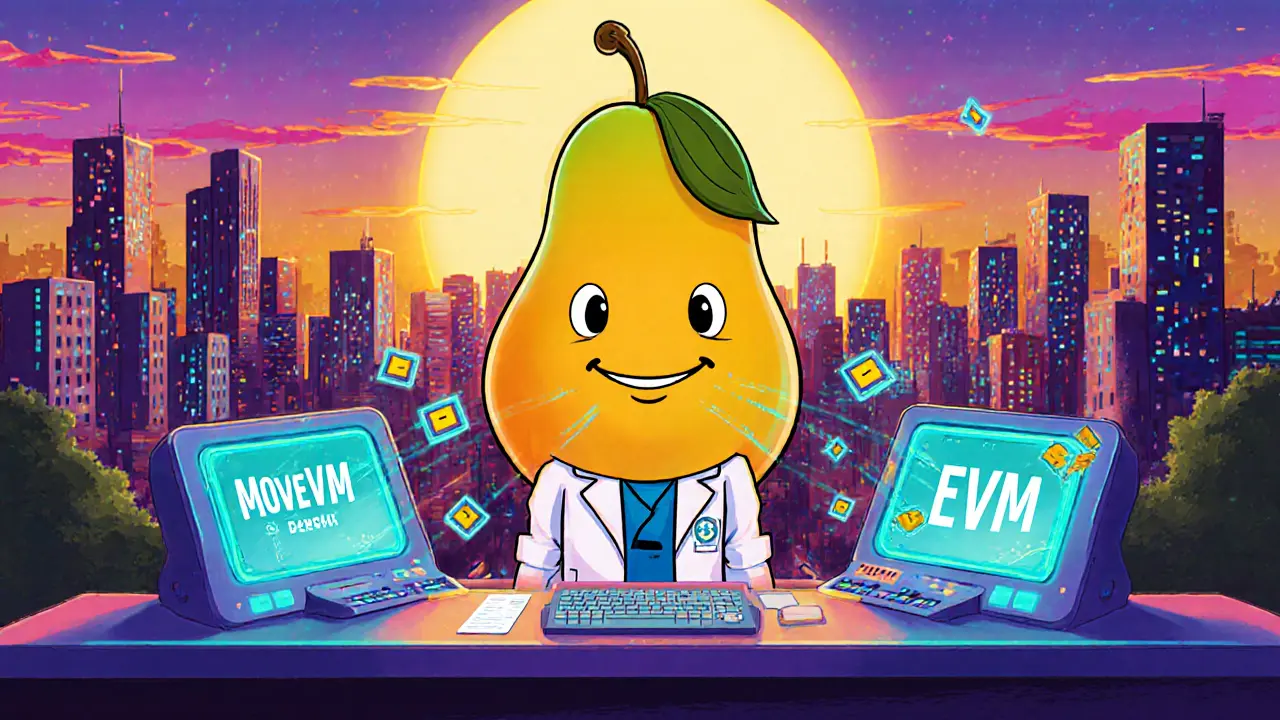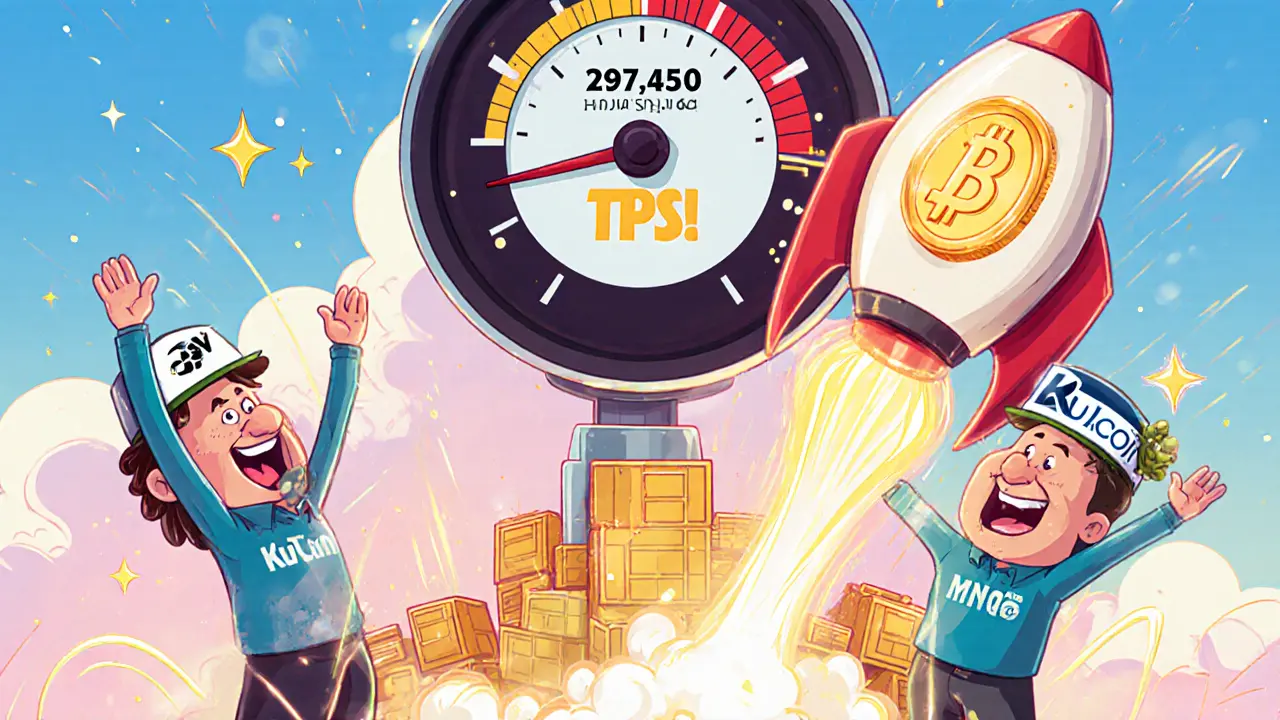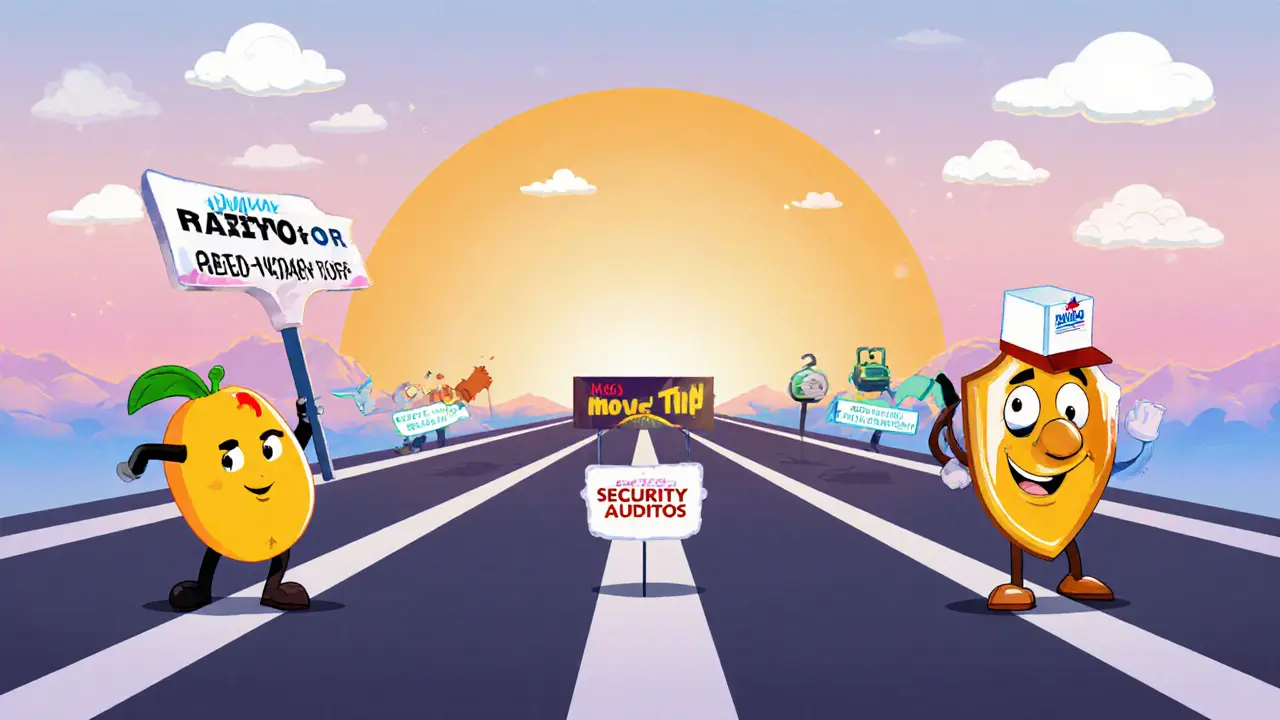
MGO Token Price Tracker
Current Market Data
Tokenomics Overview
Performance Chart
Last 10 Days Price Performance
Investment Calculator
Investment Summary
You can buy 0 MGO tokens
Estimated value: $0.00
Key Features of Mango Network
Multi-VM Support
Runs MoveVM, EVM, and SVM simultaneously for maximum flexibility
High Throughput
Up to 297,450 TPS with parallel execution and OPStack consensus
Utility Token
MGO powers network operations, governance, staking, and ecosystem incentives
Ever wondered why so many new blockchains are shouting about "multi‑VM" and "omnichain"? Mango Network is one of those projects trying to stitch together the fragmented world of Web3. In plain English, it’s a Layer1 blockchain that lets developers run both MoveVM and the Ethereum Virtual Machine (EVM) side by side, and even tap into Solana’s SVM. The native token, MGO, powers the network, rewards stakers, and lets holders vote on upgrades.
Key Takeaways
- Mango Network is a Layer1 platform that supports MoveVM, EVM, and SVM in a single chain.
- The MGO token serves utility, governance, staking rewards, and ecosystem incentives.
- Technical specs claim up to 297,450 transactions per second (TPS) while keeping security high.
- Market data (Oct2025) shows MGO trading around $0.028 with a circulating supply of ~1.59B of a 10B total.
- Funding of $13.5M from investors such as KuCoin Ventures and CatcherVC backs the project, but adoption is still early.
What Exactly Is Mango Network?
Mango Network is a Layer1 blockchain platform that combines multiple virtual machines (VMs) to create an omnichain infrastructure. It was created by MangoNet Labs and its code lives on GitHub. The goal? Solve the fragmentation that plagues DeFi and Web3 apps by letting contracts run on the VM that fits them best, without hopping between separate blockchains.
How the Multi‑VM Architecture Works
The network runs three VMs side by side:
- MoveVM - optimized for asset‑centric logic, parallel execution, and strong security (it’s the language behind Aptos and Sui).
- EVM - gives developers the massive ecosystem of Ethereum tools, Solidity contracts, and existing DeFi protocols.
- SVM (Solana Virtual Machine) - an optional layer that lets the chain speak Solana‑style contracts, widening cross‑chain possibilities.
All three VMs share the same state, so an asset created in MoveVM can be accessed instantly by an EVM contract without a bridge. This “omnichain” design is powered by OPStack technology, the open‑source stack that Ethereum’s base layer uses, ensuring compatibility with future Ethereum upgrades.
Performance Numbers that Turn Heads
According to the latest technical write‑up, Mango Network can process up to 297,450 TPS. That’s orders of magnitude higher than Bitcoin’s 7 TPS and Ethereum’s 15 TPS, and even beats Solana’s 65,000 TPS. The high throughput comes from parallel transaction execution in MoveVM combined with the lightweight consensus of OPStack. Security stays tight because the Move language enforces strict resource handling, while EVM compatibility is maintained through a well‑tested execution engine.

The MGO Token: More Than Just a Coin
MGO token (contract address 0x5e0d6791EdbEEBa6a14D1d38e2b8233257118EB1 on both Ethereum and BSC) is the blockchain’s native utility token. It serves four core roles:
- Network utility: Paying for transaction fees across all three VMs.
- Governance: Holders can vote on protocol upgrades, fee adjustments, and treasury allocations.
- Staking rewards: Validators lock up MGO to secure the network and earn a share of block rewards.
- Ecosystem incentives: Grants, launch‑pool rewards, and developer bounties are paid in MGO.
As of October2025, about 1.59B MGO tokens are circulating out of a capped 10B supply. The token’s price hovers between $0.027 and $0.030, with daily volume ranging from $3.6M to $11.5M, mostly on the MGO/USDT pair.
Market Position & Trading Landscape
Market‑cap figures differ across trackers because of the token’s recent listing surge. CryptoRank lists a $43.5M market cap, while Bitcompare shows roughly $24.7M. The token trades on nine exchanges, including Bitget, Gate.io, MXC, and XT. Price swings are typical for emerging projects: a 24‑hour change can be anywhere from -0.28% to +4.69% depending on the source.
Funding, Investors, and Token Distribution
The project raised $13.5M across several rounds. Key backers include:
- KuCoin Ventures - Tier2 venture investor.
- CatcherVC, Connectico Capital, Becker Ventures, and Tido Capital - Tier4 participants.
During a launch‑pool event (June23-July7,2025) the team airdropped 16.40M MGO tokens (0.16% of total supply) to early community members, helping bootstrap liquidity before the main exchange listings.
How Mango Network Stacks Up Against Other Layer1s
| Feature | Mango Network | Ethereum | Solana | Aptos |
|---|---|---|---|---|
| VM Support | MoveVM + EVM + SVM | EVM only | SVM only | MoveVM only |
| Max TPS | ≈297,450 | ≈15 (post‑Shanghai) | ≈65,000 | ≈160,000 |
| Native Token Price (USD) | $0.028 | $1,800 | $20 | $7 |
| Market Cap (USD) | $30‑45M (varies) | $240B | $12B | $7B |
| Developer Ecosystem | Growing, GitHub activity steady | Largest worldwide | Robust but niche | Emerging, strong community |
In short, Mango Network’s biggest advantage is flexibility: you can write Move‑based contracts for safety and speed, then drop an EVM contract into the same chain to tap into existing DeFi liquidity. The trade‑off is that the ecosystem is still thin-few dApps have launched, and developer tooling is less mature than Ethereum’s.

Potential Risks and Things to Watch
- Adoption curve: Multi‑VM is technically cool, but developers need compelling SDKs and documentation to switch.
- Security complexity: Running three VMs means three attack surfaces. Any bug in the VM bridge could expose assets.
- Market volatility: MGO’s price swing reflects its early‑stage nature; large investors could move the market.
- Competition: Established L1s (Ethereum, Solana) are already building cross‑chain bridges; Mango must prove its native solution is cheaper or faster.
How to Get Involved
If you’re curious enough to experiment, here’s a quick checklist:
- Set up a wallet that supports both Ethereum and Binance Smart Chain (e.g., MetaMask).
- Buy a small amount of MGO on an exchange that lists the MGO/USDT pair (Bitget, Gate.io, MXC).
- Stake your MGO on the official validator portal (link available on mangonet.io).
- Follow the project’s Twitter @MangoOS_Network for governance proposals and upcoming testnet releases.
- If you’re a developer, clone the GitHub repo and try deploying a simple Move contract alongside an EVM contract to see the cross‑VM communication in action.
Future Outlook
The blockchain world is moving toward modular, interoperable designs. Mango Network’s multi‑VM approach aligns with that trend, and its $13.5M funding shows investors believe the concept has legs. Success will hinge on three things:
- Delivery of a smooth developer experience (IDE plugins, documentation, sample projects).
- Strategic partnerships with DeFi protocols that need cross‑chain liquidity.
- Continued network security audits to keep the three VMs locked down.
If those boxes get ticked, MGO could move from a speculative alt‑coin to a utility token that actually powers multi‑chain dApps. If not, it may stay in the “interesting tech experiment” corner of the crypto market.
Frequently Asked Questions
What is the main purpose of Mango Network?
Mango Network aims to eliminate blockchain fragmentation by letting developers run MoveVM, EVM, and SVM contracts on a single Layer1 chain, enabling seamless cross‑chain interaction without external bridges.
How does the MGO token earn me rewards?
You can stake MGO to become a validator or delegate to one. Stakers receive a share of the block rewards plus any ecosystem incentive payouts the network decides to distribute.
Is Mango Network compatible with existing Ethereum dApps?
Yes. Because the network runs an EVM alongside MoveVM, any Solidity contract can be deployed unchanged, while still being able to call Move‑based assets on the same chain.
Where can I buy MGO?
MGO is listed on at least nine exchanges, including Bitget, Gate.io, MXC, and XT. The dominant trading pair is MGO/USDT.
What are the biggest risks of investing in MGO?
Key risks include early‑stage adoption (few dApps), potential security bugs across three VMs, and price volatility driven by low liquidity and market sentiment.

Andrew Lin
October 7, 2025 AT 09:00Alright, let me break down why Mango Network is the next big thing for us patriots. First off, the Multi‑VM support is a game‑changer – it lets us run MoveVM, EVM, and SVM all at once, which means more flexibility than any other chain out there. The throughput numbers are insane, boasting up to 297,450 TPS; that’s practically a supercomputer for decentralized apps. And let’s not forget the MGO token powering governance, staking, and incentives – a true utility token that isn’t just a speculative meme. The market cap sits at $35 million, which is still modest, so there’s massive upside if the community backs it. You’ll see the circulating supply is only 1.59 billion out of a 10 billion total, meaning scarcity is built in from day one. The high‑throughput design uses parallel execution and OPStack consensus, giving it an edge over legacy chains that choke on traffic. Oh, and the tokenomics are transparent – holders are around 25,000, a solid base for decentralised decision‑making. The price is just $0.028 right now, but with a 2.34% 24‑hour gain, it’s trending upward. If you’re still on the fence, consider the fact that this network supports real‑world applications, from finance to gaming, without the bottlenecks we’ve seen elsewhere. The community’s enthusiasm is palpable, and the roadmap promises even more VM integrations. I’ve watched the charts for months, and this upward swing isn’t a fluke; it’s a sign of real adoption. The network’s design is future‑proof, ready for scaling solutions that other blockchains struggle to implement. In short, Mango Network offers a blend of speed, flexibility, and token utility that makes it a must‑watch for anyone serious about crypto. Don’t miss out on the chance to get in early before the hype overtakes the fundamentals. The fundamentals are solid, the tech is cutting‑edge, and the community is growing every day. It’s time to back a project that aligns with our values of innovation and independence. Remember, opportunities like this don’t come around often – get your MGO while you still can.
Caitlin Eliason
October 13, 2025 AT 03:53Honestly, the moral implications of throwing money at yet another token are unsettling. We should be asking ourselves if the hype around Mango Network truly serves the greater good or just fuels speculative greed. The promise of multi‑VM support sounds impressive, but does it translate into real‑world benefits for everyday users? I’m wary of projects that prioritize flashy numbers over sustainable community impact. Let’s keep a critical eye on the governance mechanisms – are they truly decentralized or just a veneer for central control? If the token truly powers incentives and staking, those incentives must be designed ethically, not just to milk investors.
Ken Pritchard
October 18, 2025 AT 22:46Hey everyone, happy to chime in! Mango Network’s multi‑VM feature is pretty cool because it lets developers choose the best environment for their apps. The high TPS really helps avoid congestion, which is a common pain point on many chains. If you’re new to the space, you might want to experiment with the MoveVM for safer smart contract execution. Also, the token’s utility in governance means you can actually have a say in future upgrades. Feel free to ask if you need help navigating the tokenomics or staking options – happy to help!
Bryan Alexander
October 24, 2025 AT 17:40Wow, this Mango Network thing is super exciting! Imagine building apps that run on three virtual machines at once – the possibilities are endless! The 297k TPS number gives me chills; it’s like the network is ready for the next wave of massive DeFi and gaming projects. And the MGO token being used for governance means we all get a voice. Can’t wait to see what the community builds next. Keep the optimism flowing, folks!
Patrick Gullion
October 30, 2025 AT 12:33Yeah, I get the buzz, but let’s not forget that every “high‑throughput” claim needs real‑world testing. I’m curious how the parallel execution holds up under a sudden surge of users. Also, the token price is still low, which could mean it’s over‑promised. Still, it’s worth keeping an eye on – if the network lives up to the specs, it could be a solid alternative to the usual suspects.
Jack Stiles
November 5, 2025 AT 07:26Man, i think MGO sounds cool. the multi vm thing is realy neat and the tps is suuper high. id love to try staking but not sure how. if anyone got simple steps i’d appreciate. also, the price looks cheap rn so maybe a good buy. thanks!
Ricky Xibey
November 11, 2025 AT 02:20Looks legit.
Sal Sam
November 16, 2025 AT 21:13The architecture leverages a sharded consensus layer combined with an OPStack‑compatible execution engine, which theoretically reduces latency and improves finality. By integrating MoveVM alongside EVM and SVM, the platform enables cross‑compatibility, facilitating asset migration without bridge vulnerabilities. From a developer’s perspective, the SDKs for each VM are well‑documented, allowing seamless onboarding. However, the real test will be on‑chain data throughput under load – a metric that will determine if the advertised 297k TPS is sustainable beyond testnets.
Moses Yeo
November 22, 2025 AT 16:06Ah-another blockchain promises the moon!; yet, one must ponder-what truly defines "throughput"?; Is it merely raw TPS, or the genuine utility delivered to end‑users?; The philosophical underpinnings of a token being both utility and speculative instrument raise questions about value creation versus value extraction.; Perhaps the truth lies somewhere between optimism and cynicism-balanced by rigorous scrutiny.